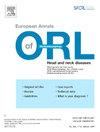Audiometry results in adult cochlear implant patients according to the electrode array
IF 2.4
4区 医学
Q2 OTORHINOLARYNGOLOGY
European Annals of Otorhinolaryngology-Head and Neck Diseases
Pub Date : 2025-09-01
DOI:10.1016/j.anorl.2025.02.005
引用次数: 0
Abstract
Objective
To assess audiological outcome in adult (> 18 years) cochlear implant (CI) users with a straight (SA) or perimodiolar electrode array (PMA).
Material and methods
Between 2017 and 2021, medical records of patients in 2 French centers who received a Cochlear™ SA (CI522/CI622) or PMA (CI532/CI632) CI were retrospectively analyzed according to the STROBE guidelines. Air-conduction pure-tone audiometry and disyllabic speech audiometry were recorded over a minimum 3-year follow-up. Only patients with thresholds above 90 dB at low frequencies (500 Hz) before surgery were considered to have residual hearing (RH). Surgery-related complications (e.g., vertigo, peripheral facial palsy, meningitis) were assessed. The significance threshold was set at P < 0.005.
Results
We included 185 adult patients: 94 SA and 91 PMA. Median age at CI was 64.5 ± 11.5 years for SA and 60.9 ± 12.2 years for PMA. Preoperative unaided pure-tone averages (PTA) were comparable between SA and PMA (100 and 102 dB, respectively; P = 0.32), as were postoperative aided free-field air-conduction PTAs at 3 months (30.9 ± 6.0 and 31.3 ± 8.8 dB, respectively; P = 0.68). Percentage correct dissyllabic word responses at 60 dB HL did not significantly differ between SA and PMA before CI (P = 0.483), or 1 year (P = 0.775), 2 years (P = 0.441) or 3 years (P = 0.785) post-CI, although there was a significant difference at 3 months post-CI (P = 0.001) in favor of PMA. Fifty-one patients (21 SA, 30 PMA) had RH prior to surgery; after 12 months’ CI experience, 14.2% of these had RH in the SA group and 13.3% in the PMA group. One peripheral facial palsy occurred in the SA group but resolved completely (P > 0.99). Twenty patients experienced transient postoperative vertigo (10 SA [10.6%], 10 PMA [10.9%]; P = 0.93). No meningitis was noted.
Conclusion
CI with straight or perimodiolar electrodes provided similar improvement in audiological performance.
成人人工耳蜗患者的听力学结果与电极排列有关。
目的:评估使用直齿(SA)或磨牙周围电极阵列(PMA)人工耳蜗(CI)的成人(bb0 ~ 18岁)听力学预后。材料和方法:2017年至2021年,根据STROBE指南回顾性分析法国2个中心接受Cochlear™SA (CI522/CI622)或PMA (CI532/CI632) CI的患者的医疗记录。在至少3年的随访中记录了空气传导纯音测听和双音节语音测听。只有术前低频(500Hz)阈值高于90dB的患者才被认为存在残余听力(RH)。评估手术相关并发症(如眩晕、周围性面瘫、脑膜炎)。结果:我们纳入185例成人患者:94例SA和91例PMA。SA患者CI中位年龄为64.5±11.5岁,PMA患者CI中位年龄为60.9±12.2岁。术前无辅助的纯音平均值(PTA) SA和PMA比较,分别为100和102dB;P=0.32),术后3个月辅助自由场空气传导pta分别为30.9±6.0和31.3±8.8dB;P = 0.68)。在CI前(P=0.483), CI后1年(P=0.775), 2年(P=0.441)或3年(P=0.785), SA和PMA之间在60dB HL下的正确双音节词反应百分比无显著差异,尽管在CI后3个月(P=0.001)有显著差异,有利于PMA。51例患者(21例SA, 30例PMA)术前有RH;经过12个月的CI治疗,SA组14.2%的患者有RH, PMA组13.3%的患者有RH。SA组出现1例周围性面瘫,但完全缓解(P>0.99)。20例患者出现术后短暂性眩晕(10例SA[10.6%], 10例PMA [10.9%];P = 0.93)。未发现脑膜炎。结论:直电极或磨牙周围电极的CI可提供类似的听力学性能改善。
本文章由计算机程序翻译,如有差异,请以英文原文为准。
求助全文
约1分钟内获得全文
求助全文
来源期刊

European Annals of Otorhinolaryngology-Head and Neck Diseases
OTORHINOLARYNGOLOGY-
CiteScore
3.70
自引率
28.00%
发文量
97
审稿时长
12 days
期刊介绍:
European Annals of Oto-rhino-laryngology, Head and Neck diseases heir of one of the oldest otorhinolaryngology journals in Europe is the official organ of the French Society of Otorhinolaryngology (SFORL) and the the International Francophone Society of Otorhinolaryngology (SIFORL). Today six annual issues provide original peer reviewed clinical and research articles, epidemiological studies, new methodological clinical approaches and review articles giving most up-to-date insights in all areas of otology, laryngology rhinology, head and neck surgery. The European Annals also publish the SFORL guidelines and recommendations.The journal is a unique two-armed publication: the European Annals (ANORL) is an English language well referenced online journal (e-only) whereas the Annales Françaises d’ORL (AFORL), mail-order paper and online edition in French language are aimed at the French-speaking community. French language teams must submit their articles in French to the AFORL site.
Federating journal in its field, the European Annals has an Editorial board of experts with international reputation that allow to make an important contribution to communication on new research data and clinical practice by publishing high-quality articles.
 求助内容:
求助内容: 应助结果提醒方式:
应助结果提醒方式:


